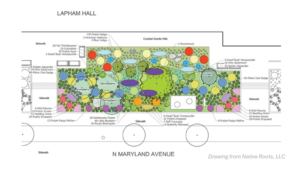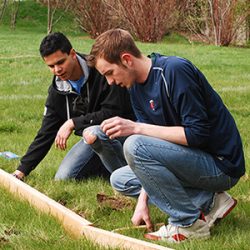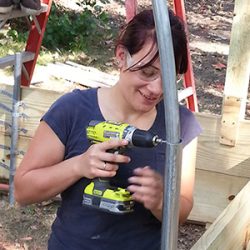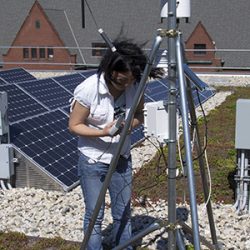
Pavilion Gateway Demonstration Project- Heat Plant Parking Lot
Parking Lot “18” near the Heat Plant and its surrounding area are the heart of The Pavilion Gateway Demonstration Project. All northerly drainage of the demonstration project comes to this site. The 5,011 sq. ft. spiral garden is planted with native species supporting ecological restoration and habitat creation goals as well as proving the point that native perennial plantings can be seen as decorative gardens in a formal campus setting. The second feature is the treatment train, a 358 linear foot system of vegetated bio-swales that captures runoff from the parking lot. The full Pavilion Gateway Report can be found here.
Lapham Hall Native Garden
In June 2023, the Office of Sustainability, Biological Sciences Greenhouse, and UWM Grounds Department collaborated to install a new native garden in front of Lapham Hall. Over 20 different native plant species will provide for local pollinators as well as provide colorful blooms to the front of Lapham Hall, home to many of UWM’s natural science programs.

Sandburg Hall Rain Garden
In order to address the severe slope, pathways, and need for water collection, a rain garden that ends in an underground cistern was developed at this site. This stormwater interpretive path meanders through a series of native plant waysides, improving water quality all the way to its underground collection. There it becomes a source of sustainable irrigation, for growing the many vegetables, herbs, and fruits of these campus gardens.
Sabin Hall Rain Garden
A disconnected downspout, native plantings, and slope design all work together to reduce the rate of stormwater runoff from the roof of Sabin Hall. Rainwater (or snowfall) is routed to the garden and filtered naturally by the plants and soils in this garden. This filtration process removes nutrients and pollutants, while retaining water closely to the site. By keeping as much rainwater as possible close to where it falls, we reduce the impact on our lakes and streams, as well as the local wildlife.
Sabin Hall rain garden was established by the student organization EcoTone. With the help of grant funding, and volunteers, this garden was planted in 2006.
Cisterns
Above Ground
Heat Plant Cisterns- 12,360 gallon double cistern
The project consists of two linked sculptural cisterns and a pair of sluices- one conveying water into the system from the Power Plant and one conveying water into the Spiral Garden as an overflow from the cisterns. A small sculptural fountain jet and a hidden lower outlet drains the system over a twenty four hour period following each rain event.
Physics Garden Catchment- 350 gallon cistern off the Physics south awning
This simple cistern not only diverts rainwater runoff from the combined sewer system, but it also helps supply half the water necessary to support 58 rented garden plots. The original concept and design was completed by UWM students in Engineers Without Borders with support from a Southeastern Wisconsin Watershed Trust grant.
Below Ground
Sandburg Garden Aqua Blox Cistern- 5,000 gallon modular cistern
This stormwater path meanders through a series of native plant waysides, improving water quality all the way to its underground Aqua Blox collection. There it becomes a source of sustainable irrigation, for growing the many vegetables, herbs, and fruits of Sandburg campus gardens.
Cambridge Cistern- 20,268 gallon cistern
This greywater system collects rainwater to water both the green roofs and the green space surrounding Cambridge Commons. The water collection can be monitored and tracked online here.
Sandburg East Tower- 8,000 gallon cistern
Kenwood Integrated Research Complex- 12,000 gallon cistern
Children’s Center Cisterns- 30,000 gallon cistern
These are multiple cisterns around campus installed underground in order to capture large amounts of stormwater runoff as part of each building’s construction.
Around the Community
Rain gardens exist throughout the community. Close by UWM there are also rain gardens at the Shorewood High School, North Point Lighthouse in Lake Park, as well as along Bradford Beach to capture and filter polluted runoff before it reaches Lake Michigan.
To find out more about planting a rain garden in your own backyard, go to:
Student Spotlight




